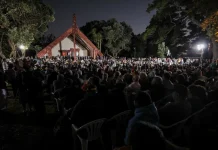Review by Selwyn Manning.
There’s so much to ponder in New Zealand Opera’s telling of the classic Puccini opera Tosca. There’s the passion, the love, the loyalty, the power and oppression set within the politics of post World War II Italy.
The political turmoil of the period provides a backstory perfectly in tune with Puccini’s story.
In 1946, Italy abandoned its monarchy and established a republic. But its political makeup was divided, the population poised on a knife’s edge. Fascist-styled oppression was still a characteristic of the power elite, and, by 1948, the Communist Party had been expelled from the Parliament and (with the help of the Vatican, NATO, and the Mafia) the Christian Democrats began an enduring hold over all estates of Italian society.
Submerged beneath the flamboyance of Italian politics, its people strove in earnest to reestablish lives long lost. Rome was a frontline, a construct of a burgeoning Cold War, where spies lurked, espionage was rife, as was intimidation and murder, where people became instruments of oppression. Secrets, fear, idealism, loyalty and love were manipulated, used by the black-gloved hand of a power-elite to destroy opposing forces, ideologies, people.
Positioned upon this backstory is New Zealand Opera’s interpretation of Puccini’s Tosca.
[caption id="attachment_7268" align="alignleft" width="200"] Ireland’s brilliant Orla Boylan was the beguiling Floria Tosca.[/caption]
Tosca, the Diva, is in love with Mario Cavaradossi. Her passion is her virtue, her jealousy is her vulnerability, the latter offers her as a pawn to be played by Baron Scarpia the chief of police.
The production team created something special here. The set, the costume, the choreography, the score were in accord perfect to the period.
The cast includes:
Ireland’s brilliant Orla Boylan was the beguiling Floria Tosca.[/caption]
Tosca, the Diva, is in love with Mario Cavaradossi. Her passion is her virtue, her jealousy is her vulnerability, the latter offers her as a pawn to be played by Baron Scarpia the chief of police.
The production team created something special here. The set, the costume, the choreography, the score were in accord perfect to the period.
The cast includes:
 Ashburton-born Simon O’Neill brought to life Mario Cavaradossi, the focus of Tosca’s love.[/caption]
Ashburton-born Simon O’Neill brought to life Mario Cavaradossi, the focus of Tosca’s love. O’Neill is an internationally acclaimed world class performer. His credentials include: principal artist with the Metropolitan Opera, the Royal Opera House, Teatro alla Scala and the Bayreuth and Salzburg Festivals. An alumnus of the University of Otago, Victoria University of Wellington, the Manhattan School of Music and the Juilliard Opera Center. He is a Fulbright Scholar and was awarded the 2005 Arts Laureate of New Zealand.
Ashburton-born Simon O’Neill brought to life Mario Cavaradossi, the focus of Tosca’s love.[/caption]
Ashburton-born Simon O’Neill brought to life Mario Cavaradossi, the focus of Tosca’s love. O’Neill is an internationally acclaimed world class performer. His credentials include: principal artist with the Metropolitan Opera, the Royal Opera House, Teatro alla Scala and the Bayreuth and Salzburg Festivals. An alumnus of the University of Otago, Victoria University of Wellington, the Manhattan School of Music and the Juilliard Opera Center. He is a Fulbright Scholar and was awarded the 2005 Arts Laureate of New Zealand.
 Tosca’s passion was counterbalanced by her inability to escape the grip of Scarpia’s leathered black hand.[/caption]
This was all in evidence as he performed Cavaradossi. It was so easy to become lost within his song, his character, his merit. But one was soon lured back to centre-stage by Tosca’s passion counterbalanced by her inability to escape the grip of Scarpia’s leathered black hand, played by Hastings-born Phillip Rhodes.
Tosca’s passion was counterbalanced by her inability to escape the grip of Scarpia’s leathered black hand.[/caption]
This was all in evidence as he performed Cavaradossi. It was so easy to become lost within his song, his character, his merit. But one was soon lured back to centre-stage by Tosca’s passion counterbalanced by her inability to escape the grip of Scarpia’s leathered black hand, played by Hastings-born Phillip Rhodes.
 The sinister Scarpia performed by Hastings-born Phillip Rhodes.[/caption]
The supporting artists were superb: Australia’s James Clayton played the sinister but loyal Cesare Angelotti, New Zealanders Barry Mora played A Sacristan, James Benjamin played Spoletta, and Wade Kernot played Sciarrone.
[caption id="attachment_7270" align="alignleft" width="210"]
The sinister Scarpia performed by Hastings-born Phillip Rhodes.[/caption]
The supporting artists were superb: Australia’s James Clayton played the sinister but loyal Cesare Angelotti, New Zealanders Barry Mora played A Sacristan, James Benjamin played Spoletta, and Wade Kernot played Sciarrone.
[caption id="attachment_7270" align="alignleft" width="210"] Tosca provides us an opportunity to ponder the frailties of our humanity, made vulnerable by the times and powers we all live in.[/caption]
And of course, the Freemasons New Zealand Opera Chorus was exceptional, and the opera’s score was powerfully performed in Auckland by the fabulous Auckland Philharmonia Orchestra, conducted by Sweden’s Tobias Ringborg.
Tosca provides us an opportunity to ponder the frailties of our humanity, made vulnerable by the times and powers we all live in.[/caption]
And of course, the Freemasons New Zealand Opera Chorus was exceptional, and the opera’s score was powerfully performed in Auckland by the fabulous Auckland Philharmonia Orchestra, conducted by Sweden’s Tobias Ringborg.
AUCKLAND:
ASB Theatre, Aotea Centre, Accompanied by the Auckland Philharmonia Orchestra – Wednesday September 23 and 25 at 7.30pm and September 27 at 2.30pm.
WELLINGTON:
St James Theatre, Accompanied by the New Zealand Symphony Orchestra – October 10, 15, 17 at 7.30pm and October 13 at 6pm.
For more, see www.NZOpera.com
—








